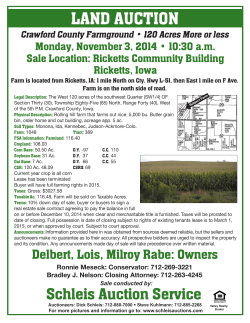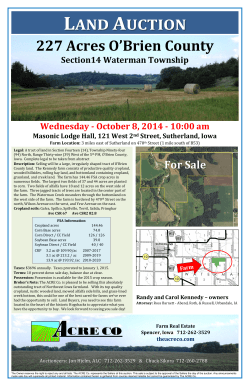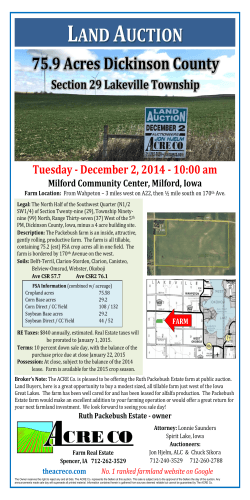
Agricultural Act of 2014 2014 Farm Bill Fact Sheets & Online Resources
Agricultural Act of 2014 2014 Farm Bill Fact Sheets & Online Resources for Illinois farmers Produced and provided by: Illinois Farm Bureau® Winter 2014/2015 Table of Contents Commodities Title/Safety Net Overview .................................. 1 Payment Yield Update Options.................................................... 3 Base Acreage Reallocation Options ............................................ 5 Price Loss Coverage (PLC) ............................................................ 7 Ag Risk Coverage-County (ARC-CO) ............................................ 9 Ag Risk Coverage-Individual (ARC-IC) ....................................... 11 Supplemental Coverage Option (SCO) ...................................... 15 Online Resources ............................................... inside of back cover Note: Farm Bill rules and regulations are subject to change. This document is current as of the date of publication, but the rules and regulations discussed in it are subject to change. Illinois Farm Bureau contact: Doug Yoder, Sr. Director of Affiliate and Risk Management [email protected] Published: November 20, 2014 Copyright: Illinois Farm Bureau® © 2014 Illinois Farm Bureau 2014 Farm Bill Fact Sheets Commodities Title/Safety Net Overview The 2014 Farm Bill was passed on February 7, 2014 and covers five crop years: 2014 – 2018. The bill contains several one-time, irrevocable options for landowners and producers. Landowners 1) Payment Yields – landowners may either: a) Retain the payment yields currently on record on their farms at the Farm Service Agency (FSA); or, b) Update payment yields to 90% of the simple average of covered crop yield per planted acre for the 2008 – 2012 crop years. 2) Base Acreage – landowners may either: a) Retain base acreage on file with FSA as of 9/30/2013; or, b) Reallocate base acres according to the ratio of planted acres on each farm for harvest, haying, grazing and silage from 2009 – 2012, including prevent plant acres. See individual fact sheets on Payment Yields and Base Acreage for full details. Producers – defined as an owner, operator, landlord, tenant, or sharecropper that shares in the risk of producing a crop and is entitled to share in the crop available for marketing from the farm, or would have shared had the crop been produced, including anyone with an interest/share in Conservation Reserve Program acreage. Producers have a one-time option to choose one of three safety net options per FSA farm: 1) Price Loss Coverage (PLC)- the default choice if no other option elected; • Farms choosing PLC are eligible for new crop insurance county-based supplemental coverage called Supplemental Coverage Option (SCO). 2) Ag Risk Coverage, county coverage (ARC-CO); or, 3) Ag Risk Coverage, individual coverage (ARC-IC) If no election is made, PLC is the default, and any possible payments for 2014 are forfeited. See individual fact sheets for full details on PLC, ARC-CO, ARC-IC, and SCO. Timeline – The timeline to make these choices at FSA offices is as follows: • September 29, 2014 – February 27, 2015: Payment Yield Update and Base Acre Reallocation • November 17, 2014 – March 31, 2015: ARC/PLC Election • Mid-April – Summer 2015: Annual Enrollment Once the various sign-up periods expire, the choices made cannot be changed for the remainder of this farm bill. 1 Marketing Loan Program Regardless of the ARC/PLC selection, access to the Marketing Loan Program is available including a nine-month nonrecourse loan or Loan Deficiency Payment. National loan rates remain unchanged for corn, soybeans, wheat and oats. Eligibility Tests 1) Adjusted Gross Income - Producers whose average AGI exceeds $900,000 are not eligible to receive payments or benefits from most programs administered by FSA and the Natural Resources Conservation Service (NRCS). Previous AGI provisions distinguished between farm and non-farm AGI. 2) Actively Engaged - Producers who participate in the PLC or ARC programs are required to provide significant contributions to the farming operation to be considered as “actively engaged in farming.” The new farm bill requires the USDA to develop and publicize new regulations to define “significant contribution of active personal management” as part of this determination. Payment Limits The total amount of payments received, directly and indirectly, by a person or legal entity (except joint ventures or general partnerships) for PLC, ARC, marketing loan gains, and loan deficiency payments (other than for peanuts), may not exceed $125,000 per crop year. Conservation Compliance The 2014 farm bill continues to require an acreage report for all cropland on the farm. The acreage report is required to be eligible for PLC, ARC, marketing assistance loans, and loan deficiency payments. Compliance with Highly Erodible Land Conservation (HELC) and Wetland Conservation (WC) provisions continues to be required for participation in most FSA and NRCS programs. These provisions place restrictions on the planting of an agricultural commodity on highly erodible land or wetlands. In addition, they prohibit the conversion of a wetland in order to produce an agricultural commodity. The 2014 farm bill ties premium assistance for crop insurance to compliance with HELC and WC provisions. If a producer is determined to be out of compliance on any part of their land, they lose premium assistance (subsidy) on all of their crop insurance, starting the next crop insurance year - compliance must be met on all of a producer’s land to retain eligibility for crop insurance premium assistance. FSA will make HELC/WC eligibility determinations for crop insurance participants based on NRCS technical determinations of HELC/WC compliance. Fact sheets, data sheets, listing of state-wide farm bill meetings, and recorded webinars can be found at www.ilfb.org/farmbill 2 Illinois Farm Bureau 2014 Farm Bill Fact Sheets Payment Yield Update Options The safety net provisions contained in the 2014 Farm Bill utilize payment yields and base acreage established with the Farm Service Agency (FSA) when calculating benchmarks and potential payments. Landowners are provided a one-time, irrevocable option to: 1) Retain the payment yields currently established on their farms at FSA; or, 2) Update payment yields to 90% of the simple average of covered crop yield per planted acre for the 2008 – 2012 crop years. Considerations: 1) The owner(s) of each FSA farm makes the decision; 2) The payment yield update decision is by crop by farm. You can update all covered crops on an FSA farm, only certain covered crops, or none for example; 3) The payment yield update decision is independent of the base acreage reallocation decision. Per farm, landowners can both update payment yield and reallocate base, one or the other, or neither; 4) When calculating potential updated yield: a. A year is excluded from the calculation if no acres were planted to that covered crop; b. A “substitute yield” of 75% of the county’s 2008-2012 average yield can be used if the farm yield is less than the substitute yield. Substitute yields for all Illinois counties are available at: www.ilfb.org/farmbill 5) Updated payment yields are allowed for all farms. However, only farms selecting the Price Loss Coverage (PLC) will utilize the updated yields. Farms selecting ARC-CO or ARC-IC will use previously established payment yields; 6) Even though updated payments yields will only be utilized by PLC farms, all farms should update payments if the updated yield is higher than the previously established yield on that farm. Not every farm bill allows the opportunity to update yields so this opportunity should be utilized if advantageous. Future farm programs may use these updated yields; 7) If no action is taken, the farm will default to the current payment yields already established with FSA. Yield Certification – 1) Yield and production records are not required with the yield certification form during update process, however, owners must be prepared to submit records used to certify yields if requested. 2) Use of crop insurance production data to certify is encouraged: a. The individual farm yields used to develop the farm Actual Production History (APH) may be used, but not the APH 4-10 year average itself; and b. Trend-Adjusted yields cannot be used. 3 Allowable production/yield evidence includes: • Crop insurance APH records • Settlement sheets/scale tickets • On-farm storage measured by FSA or crop insurance representative • Livestock feed records • FSA: loan records, ACRE records, Noninsured Crop Disaster Assistance Program (NAP) FSA will not copy or store yield or production records. The following table contains an example of a corn payment yield update scenario illustrating the various rules described above. Decision tools are available to assist landowners in analyzing their payment yield scenarios. These tools can be accessed at http://fsa.usapas.com/ Fact sheets, data sheets, listing of state-wide farm bill meetings, and recorded webinars can be found at www.ilfb.org/farmbill 4 Illinois Farm Bureau 2014 Farm Bill Fact Sheets Base Acreage Reallocation Options The safety net provisions contained in the 2014 Farm Bill utilize payment yields and base acreage established with the Farm Service Agency (FSA) when calculating benchmarks and potential payments. Landowners are provided a one-time, irrevocable option to: 1) Retain the base acres on file with FSA as of 9/30/13; or, 2) Reallocate the base acreage using the ratio of the 2009-2012 crop years average planted acres on each farm for harvest, haying, grazing and silage, including prevent plant acres. Considerations: 1) The owner(s) of each FSA farm makes the decision; 2) Total base acreage per FSA farm cannot be increased, only reallocated; 3) The base acreage reallocation decision is independent of the payment yield update decision. Per farm, landowners can both update payment yield and reallocate base, one or the other, or neither; 4) If base is reallocated, it applies to all covered crops on that farm and takes effect beginning with the 2014 crop year; 5) All years from 2009-2012 are included regardless of whether or not acres were planted to a covered crop; 6) Base acres can include double crop acres if the USDA has determined that double cropping is an established practice in the area. In other areas, if 2 crops were planted on the same acre in the same year, the owner may elect 1 but not both covered crops when calculating the 4-year average of base acres; 7) Total base acres on an FSA farm cannot exceed that farm’s actual cropland acreage, unless double cropping is an approved practice; 8) If no action is taken, the farm will default to the base acreage allocation currently established with FSA. There are two primary alternative approaches to consider when making the base acreage reallocation decision: 1) Risk Management approach – Consideration would be given to elect base acreage allocation most closely matching expected planting patterns/crop rotations during the 2015-2018 crop years to enhance/supplement your risk management coverage; or, 2) Maximizing farm program payments approach - Use available decision tools to determine highest likelihood of program payments over time. Consideration should also be given to the uncertainty of what future farm programs will consist of, including the unknown ability to reallocate base acreage again in the future. 5 The following table contains three examples illustrating the various rules and considerations described above. Example 1: Both current base acreage allocation and reallocation percentage are the same, offering no real option for this landowner. This illustrates that the only reallocation potential is based on the actual planted acreage ratio from 2009-2012, no mixing and matching or blending of planted acreage is allowable. Example 2: Options include; 1) retain current 80 acres of corn base and 20 acres of soybean base, or 2) reallocate to 50 acres of corn base and 50 acres of soybean base based on the 4-year ratio of planted acres. Example 3: This example illustrates that even though there are more tillable acres than base, base acres cannot be increased. Options include; 1) retain current 50 acres of corn base and 50 acres of soybean base; or 2) reallocate to 75 acres of corn base and 25 acres of soybean base based on the 4-year ratio of planted acres. Decision tools are available to assist landowners in analyzing their base acreage reallocation options. These tools can be accessed at http://fsa.usapas.com/ Fact sheets, data sheets, listing of state-wide farm bill meetings, and recorded webinars can be found at www.ilfb.org/farmbill 6 Illinois Farm Bureau 2014 Farm Bill Fact Sheets Price Loss Coverage (PLC) The 2014 Farm Bill provides producers a one-time, irrevocable choice of one of three safety net options on each Farm Service Agency (FSA) farm. For purposes of the 2014 farm bill, producers are defined as an owner, operator, landlord, tenant, or sharecropper that shares in the risk of producing a crop and is entitled to share in the crop available for marketing from the farm, or would have shared had the crop been produced, including anyone with an interest/share in Conservation Reserve Program (CRP) acreage. The three safety net options include: 1) Price Loss Coverage (PLC) - the default choice if no other option elected; 2) Ag Risk Coverage, county coverage (ARC-CO); or, 3) Ag Risk Coverage, individual coverage (ARC-IC). PLC and ARC-CO decision can be made by crop, by farm. For ARC-IC, all covered crops on all farms in the state will be combined into one benchmark revenue and payment calculation. If no election is made, PLC is the default, and any possible payments for 2014 are forfeited. Price Loss Coverage (PLC) 1) Target price program, modified version of the Counter-Cyclical Program in the 2008 farm bill 2) Reference prices established for the life of the farm bill and will not change 3) Payments made on 85% of base acres if payments are triggered 4) Issues payment if the higher of a) the Market Year Average (MYA) price, or b) loan rate is below the established reference price for that covered crop 5) The only option that will utilize updated payment yields 6) The only option allowing Supplemental Coverage Option (SCO) eligibility Reference Prices: Crop Reference Price Crop Corn $3.70 Grain Sorghum $3.95 Soybeans $8.40 Barley $4.95 Wheat $5.50 Rice $14/cwt Oats $2.40 Peanuts $535/ton 7 Reference Price PLC Example Assumptions: • 2014 MYA price = $3.50 (USDA estimate: November 10, 2014) • Farm’s payment yield = 150 bushels • Corn base = 100 acres Payment Calculations: • Payment rate = $.20/bushel ($3.70 reference price - $3.50 MYA price) • Total payment = $2,550* ($.20 payment x 150 bushels payment yield x 85 payable base acres) • Payment per base acre = $25.50 *Payment would be distributed by farm share percentage. Fact sheets, data sheets, listing of state-wide farm bill meetings, and recorded webinars can be found at www.ilfb.org/farmbill 8 Illinois Farm Bureau 2014 Farm Bill Fact Sheets Ag Risk Coverage-County (ARC-CO) The 2014 Farm Bill provides producers a one-time, irrevocable choice of one of three safety net options on each Farm Service Agency (FSA) farm. For purposes of the 2014 farm bill, producers are defined as an owner, operator, landlord, tenant, or sharecropper that shares in the risk of producing a crop and is entitled to share in the crop available for marketing from the farm, or would have shared had the crop been produced, including anyone with an interest/share in Conservation Reserve Program acreage. The three safety net options include: 1) Price Loss Coverage (PLC) - the default choice if no other option elected; 2) Ag Risk Coverage, county coverage (ARC-CO); or, 3) Ag Risk Coverage, individual coverage (ARC-IC). PLC and ARC-CO decision can be made by crop, by farm. For ARC-IC, all covered crops on all farms in the state will be combined into one benchmark revenue and payment calculation. If no election is made, PLC is the default, and any possible payments for 2014 are forfeited. Ag Risk Coverage-County (ARC-CO) 1) County level revenue protection 2) ARC-CO benchmark revenue and payment calculations will be based on FSA administrative county, not the county the land is physically located in 3) County revenue benchmark guarantee = 86% of: a. 5-year rolling Olympic average of county yield; and, b. 5-year rolling Olympic average of Market Year Average Price (MYA) 4) The crop’s reference price will be substituted for any individual MYA prices that were actually below the reference price for the benchmark calculation 5) Actual County Revenue = final county yield x final MYA 6) Payments issued if actual county revenue is less than county benchmark revenue guarantee 7) Maximum payment = 10% of county benchmark revenue for that year 8) Payments will be issued on 85% of base acres 9) Separate benchmark revenue guarantees and payments for each covered crop 10) No annual production evidence required 11) Not eligible to use updated payment yields 12) Not eligible for Supplemental Coverage Option (SCO) 9 ARC-CO Example for McLean County, IL for 2014 crop year County Yield MYA Price 2009 2010 2011 2012 2013 Olympic Average 186 170 160 110 190 172 $3.70* $5.18 $6.22 $6.89 $4.46 $5.29 *2009 actual MYA was $3.55, but $3.70 reference price is substituted • • • • Use of Olympic average does not include the high or low years, so the county yields and MYA prices underlined above are the ones used to calculate the Olympic average County benchmark revenue = $910/acre (172 Olympic average yield x $5.29 Olympic average price) County revenue guarantee = $783/acre ($910 benchmark x 86% guarantee) Maximum payment = $91/acre ($910 benchmark x 10%) Assumptions: • MYA price for 2014 = $3.50 (USDA estimate November 10, 2014) • Final county yield = 180 bushels • Corn base = 100 acres Payment Calculations: • Actual County Revenue = $630 (180 final county yield x $3.50 MYA price) • Payment Rate = $153/acre ($783 guarantee - $630 final revenue) • Payment Rate used = $91 (maximum payment since $153 exceeds max) • Total Payment = $7,735* ($91 max payment x 100 base acres x 85% of base) • Payment/Base Acre = $77.35 *Payment would be distributed by farm share percentage. Fact sheets, data sheets, listing of state-wide farm bill meetings, and recorded webinars can be found at www.ilfb.org/farmbill 10 Illinois Farm Bureau 2014 Farm Bill Fact Sheets Ag Risk Coverage-Individual (ARC-IC) The 2014 Farm Bill provides producers a one-time, irrevocable choice of one of three safety net options on each FSA farm. For purposes of the 2014 farm bill, producers are defined as an owner, operator, landlord, tenant, or sharecropper that shares in the risk of producing a crop and is entitled to share in the crop available for marketing from the farm, or would have shared had the crop been produced, including anyone with an interest/share in Conservation Reserve Program (CRP) acreage. The three safety net options include: 1) Price Loss Coverage (PLC) - the default choice if no other option elected; 2) Ag Risk Coverage, county coverage (ARC-CO); or, 3) Ag Risk Coverage, individual coverage (ARC-IC). PLC and ARC-CO decision can be made by crop, by farm. For ARC-IC, all covered crops on all farms in the state will be combined into one benchmark revenue and payment calculation. If no election is made, PLC is the default, and any possible payments for 2014 are forfeited. Ag Risk Coverage-Individual (ARC-IC) 1) Whole farm revenue protection a. Provides farm level revenue loss coverage, weighted to the producer’s share of the covered commodities planted, across ALL farms enrolled in ARC-IC in the state 2) Farm revenue benchmark guarantee = 86% of: a. 5-year rolling Olympic average of annual farm revenues for all covered crops on all ARC-IC farms in the state, weighted by planted acreage ratio b. Annual farm revenue = The higher of the individual farm yield or substitute yield (70% of county transitional yield) times the higher of the Market Year Average (MYA) price or loan rate i. For any year with zero planted acres, an “assigned” yield of 100% of the county average will be used. ii. The crop’s reference price will be substituted for any individual MYA prices that were actually below the reference price for the benchmark calculation. 11 3) Payments will be issued when Actual Crop Revenue is less than the ARC-IC Guarantee a. Actual Crop Revenue = Sum of production of each covered commodity times the higher of MYA price or loan rate 4) Maximum payment = 10% of weighted producer benchmark revenue 5) Payments will be issued on 65% of base acres 6) At least one covered commodity has to be planted for payment eligibility 7) Prevent Plant acres are not included in ARC-IC calculations unless 100% of covered commodities are Prevent Plant 8) Annual production evidence required for benchmark and actual revenue calculations 9) Not eligible to use updated payment yields 10) Not eligible for Supplemental Coverage Option (SCO) ARC-IC Example for 2014 crop year To simplify, only one FSA farm will be used in this example. In reality, all farms the producer has an interest in across the state will be combined for benchmark and actual revenue calculations. 12 This farm’s Olympic average (eliminating high and low years) revenue would equal: • Corn = $829 ($881+$758+$847 divided by 3) • Soybeans = $690 ($667+$700+$702 divided by 3) The 2014 planting acre ratio for this farm was 60% corn and 40% soybeans. • • • Whole farm benchmark revenue would equal $773 ($829 x .60 + $690 x .40) Farm level ARC-IC revenue guarantee would equal $665 ($773 x 86%) Maximum ARC-IC payment would equal $77/acre ($773 x 10%) Assumptions used to calculate 2014 whole farm actual revenue: • Corn MYA price = $3.50 (USDA Nov. 10, 2014 estimate) • 180 bushel/acre corn actual yield • Soybean MYA price = $10.00 (USDA Nov. 10, 2014 estimate) • 56 bushel/acre soybean actual yield Payment Calculations: • Whole Farm Actual Revenue = $602/acre {.60 x ($3.50 x 180) + .40 x ($10.00 x 56)} • Payment Rate = $63 ($665 revenue guarantee - $602 actual revenue) • Total Payment = $4,095* ($63/acre payment x 100 base acres x 65% of base acres) • Payment/Base Acre = $40.95 *Payment would be distributed by farm share percentage. Fact sheets, data sheets, listing of state-wide farm bill meetings, and recorded webinars can be found at www.ilfb.org/farmbill 13 14 Illinois Farm Bureau 2014 Farm Bill Fact Sheets Supplemental Coverage Option (SCO) The 2014 Farm Bill authorized a new crop insurance supplement called Supplemental Coverage Option (SCO). SCO is designed to add to, or supplement, the coverage producer’s purchase for their operations thus reducing the deductible left from their underlying crop insurance policy. SCO is only available for crops that choose the Price Loss Coverage (PLC) safety net option in the 2014 Farm Bill. Any crop on a farm that elects either of the Ag Risk Coverage (ARC) revenue options in the farm bill is not eligible for SCO. Thus, analysis of SCO needs to be incorporated into producer’s ARC/PLC decision process. Considerations: 1) County-based area supplemental coverage 2) Only crops on farms that elect PLC are eligible for SCO coverage 3) Producers must first purchase Yield Protection (YP), Revenue Protection (RP), or Revenue Protection with the Harvest Price Exclusion (RP-HPE)to be eligible to purchase SCO 4) 65% of SCO premiums will be paid by the Risk Management Agency (RMA) 5) SCO mimics the underlying crop insurance coverage, for example: a. If YP is purchased, SCO will provide supplemental county yield coverage; b. IF RP is purchase, SCO will provide supplemental county revenue coverage that automatically uses the higher of the base or harvest crop insurance price just as RP does; c. If RP-HPE is purchased, SCO will provide supplemental county revenue coverage that only uses the base crop insurance price 6) SCO coverage begins at 86% of county yield or revenue and ends at the producer’s underlying crop insurance coverage level. If producer purchases: a. 85% coverage level, SCO provides 1% additional coverage (86% - 85%); b. 80% coverage level, SCO provides 6% additional coverage (86% - 80%); c. 75% coverage level, SCO provides 11% additional coverage (86% - 75%); d. 70% coverage level, SCO provides 16% additional coverage (86% - 70%); e. And so forth 7) Given that SCO is a county-based coverage, it will operate similarly to areabased crop insurance plans now called Area Risk Protection Insurance (ARPI), formerly known as Group Risk Plan (GRP) and Group Risk Income Protection (GRIP), meaning: a. SCO will utilize the same “Expected County Yields” as ARPI; b. SCO will utilize the same base and harvest prices as ARPI; c. SCO will not offer replant provisions; d. SCO will not offer Prevent Plant provision; e. SCO will not offer quality loss coverage such as aflatoxin for corn and vomitoxin for wheat; and, f. One distinct and important difference between SCO and ARPI is that SCO will not offer the multiplier (protection level) that ARPI offers. 15 8) Even though SCO needs to be incorporated into producer’s farm bill safety net ARC/PLC decision, producer’s will purchase SCO through crop insurance providers since it is a crop insurance tool, not through the Farm Service Agency 9) Since SCO is a crop insurance tool, it will not be subject to a) the 3-year Adjusted Gross Income eligibility requirement, and b) the payment limitations that ARC/PLC are subject to 10) Another distinction between SCO and ARC/PLC is SCO coverage will be on planted acres and actual production as compared to base acreage and established payment yields that ARC/PLC coverage is based on 11) If you plant a crop without base on a farm you may purchase SCO for that crop on that farm since you did not elect ARC on that crop, as there is no base 2015 Availability in Illinois • Available in all Illinois counties for corn and soybeans • Available in 28 Illinois counties for wheat: • • • • • • • • • • • Bond Clay Clinton Crawford Edwards Franklin Greene Hamilton Jackson Jefferson • • • • • • • • • • Kankakee Lawrence Livingston Macoupin Madison Marion Mason Monroe Montgomery Perry • • • • • • • • Randolph Richland Schuyler Shelby St. Clair Washington Wayne White Beginning in the 2016 crop year, the (RMA) will expand SCO coverage into more areas, more crops, and to make SCO coverage more practice-specific such as irrigated vs. non-irrigated Special Consideration for Wheat for 2015 Crop Year • The deadline to purchase crop insurance, including SCO, for wheat for the 2015 crop year was September 30, 2014. To allow producers additional time to make an informed decision on ARC/PLC, producers are allowed to withdraw SCO coverage by the earlier of their acreage reporting date or December 15, 2014 without penalty or being charged any premium. • After this one-time exemption for 2015 crop year fall-planted wheat, if SCO is chosen on a farm that elected ARC on that same farm and crop, the SCO coverage will be cancelled, and the producer forfeits 20% of the SCO premium to cover administrative expenses. The producer’s underlying policy will remain in effect. 16 SCO Example Assumptions used for example: • Revenue Protection (RP) was purchased at 80% coverage level • The Trend-Adjusted Actual Production History (TA-APH) for this farm = 190 bushels per acre (bpa) • Expected county yield for SCO = 180 bpa • 2014 crop insurance base price = $4.62 Calculations: • Expected farm revenue = $878 (190 bpa x $4.62) • RP guarantee = $702 (190 bpa x $4.62 x 80% coverage level) • Expected county revenue = $832 (180 bpa x $4.62) • SCO trigger = $715 (180 bpa x $4.62 x 86% coverage trigger level) • SCO lower coverage band = $665 (180 bpa x $4.62 x 80% coverage level) • SCO coverage range = $50/acre ($715 SCO trigger - $665 lower coverage band) • Maximum SCO payment = $53 (190 TA-APH x $4.62 x 6% SCO coverage band) SCO claim calculations: • 2014 harvest price = $3.49 • Final county yield = 200 bpa • Final county revenue = $698 ($3.49 x 200 bpa) • $715 SCO trigger - $698 final county revenue = $17 shortfall • Percentage shortfall = 34% ($17 shortfall out of $50 band of coverage) • SCO payment = $18/acre ($53 maximum payment x 34% shortfall) 17 Independent Claim Payments Possible SCO claims will not offset or reduce any possible claims from the underlying crop insurance coverage producers may have, and vice versa. The following table illustrates the four possible claim payment outcomes when SCO is combined with Revenue Protection (RP) as an example: Fact sheets, data sheets, listing of state-wide farm bill meetings, and recorded webinars can be found at www.ilfb.org/farmbill 18 Illinois Farm Bureau 2014 Farm Bill Fact Sheets Notes 19 Illinois Farm Bureau 2014 Farm Bill Fact Sheets Notes 20 Illinois Farm Bureau 2014 Farm Bill Fact Sheets Notes 21 Illinois Farm Bureau 2014 Farm Bill Fact Sheets Notes 22 Illinois Farm Bureau 2014 Farm Bill Fact Sheets Online Resources • ILFB Farm Bill Page: www.ilfb.org/farmbill Fact sheets Data sheets for all Illinois Counties (corn, beans, wheat, oats, sorghum): o Substitute Yields for Payment Yield Update Option o ARC-CO Benchmark, Revenue Guarantee Data, & Max Payments o ARC-IC Assigned & Substitute Yields Recorded webinars PowerPoint presentation • farmdoc Farm Bill Toolbox: http://farmbilltoolbox.farmdoc.illinois.edu/index.html • FSA Farm Bill Page: www.fsa.usda.gov/arc-plc • Online Decision Tool: http://fsa.usapas.com/ • RMA Farm Bill Page: http://www.rma.usda.gov/news/currentissues/farmbill/ • RMA Crop Insurance Decision Tool: http://prodwebnlb.rma.usda.gov/apps/CIDT/
© Copyright 2025








